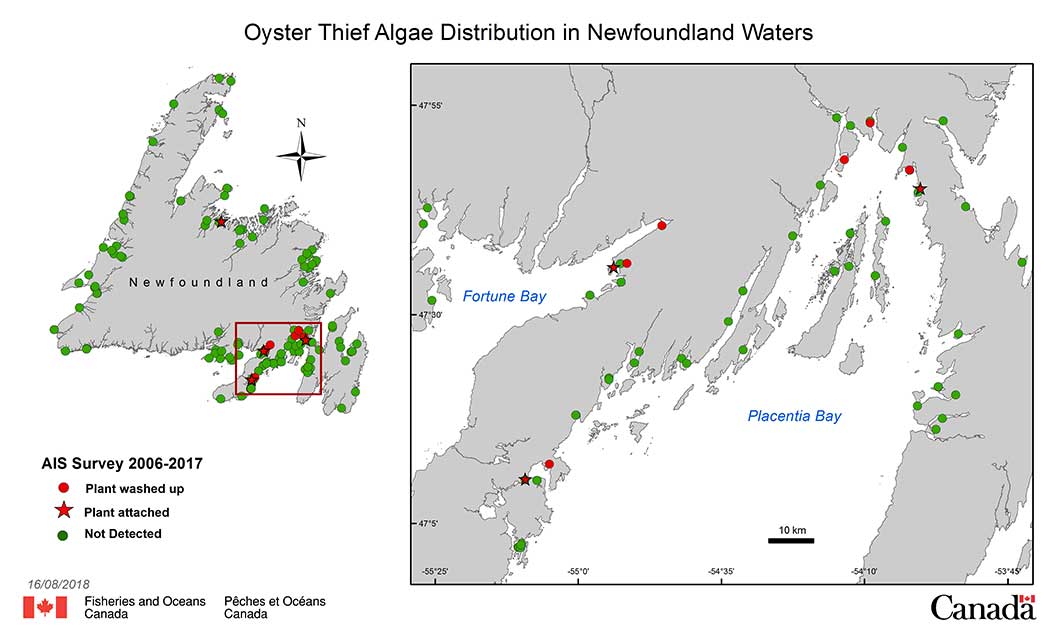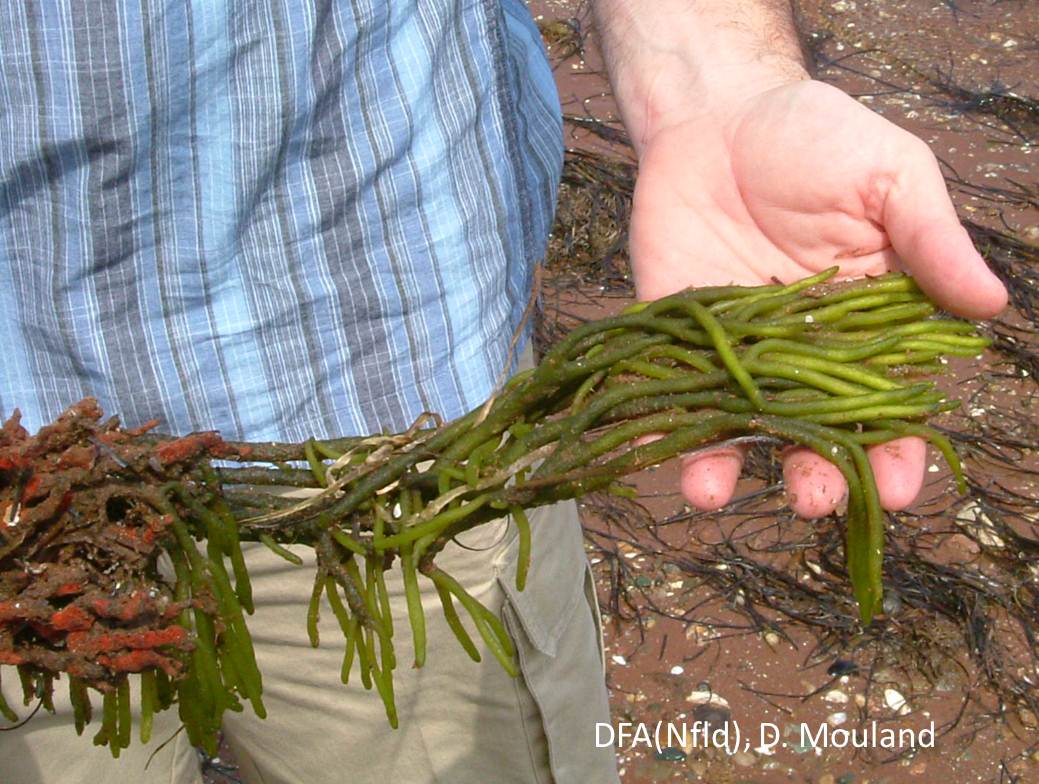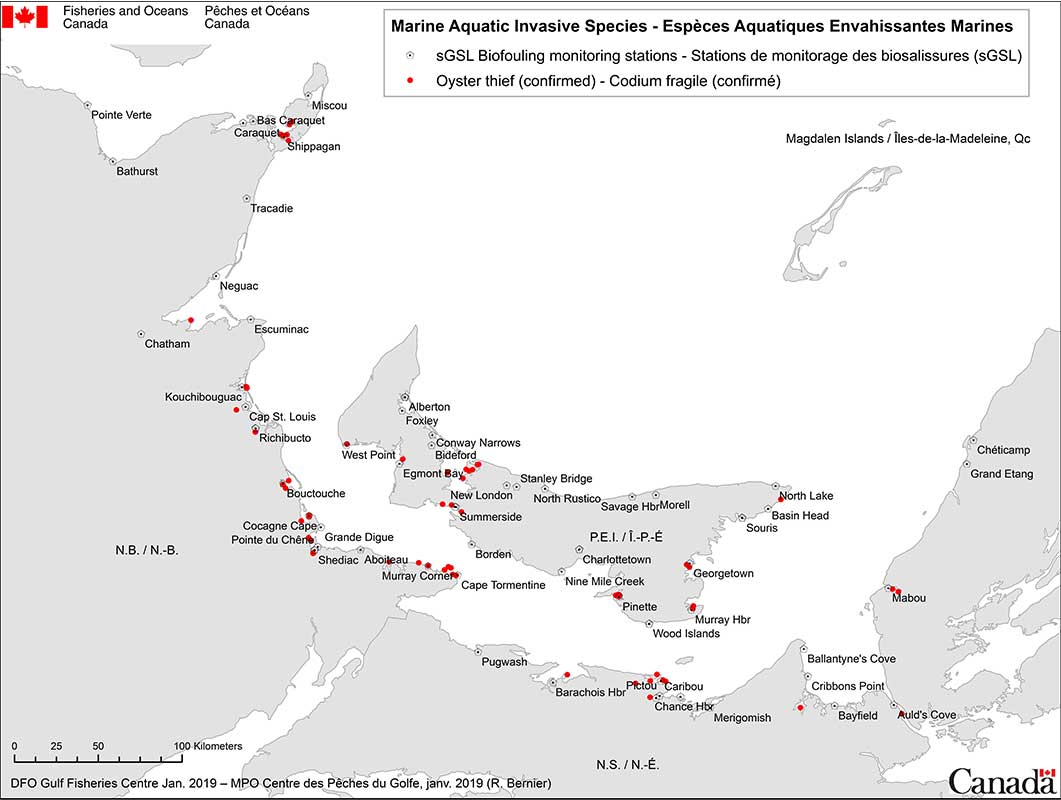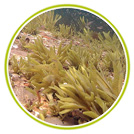Oyster Thief
Codium fragile
Report it
If you think you have found an aquatic invasive species:
- take photos
- note:
- the exact location (GPS coordinates)
- the observation date
- identifying features
- contact us to report it
The Oyster Thief is a green alga that grows in subtidal, shallow waters along the coast. It is characterized by numerous dark green cylindrical branches that arise from its holdfast, which keeps the plant attached to the seabed. The plant can grow up to 90 cm and when alive the branches are described as soft and fuzzy in texture. Juvenile stages of Oyster Thief appear as fuzzy, moss-like mats.
Identifying features
- Shaped like a small bush, soft and velvety as a sponge to the touch;
- Colour: light to dark green;
- Thick and spongy, Y-shaped cylindrical branches, 3 to 10 mm in diameter;
- Size: up to 90 cm long;
- Weight: up to 3 kg per plant;
- When found on the beach, the branches may bleach white and resemble fat spaghetti.
Similar species (native)
Oyster Thief can easily be distinguished from native seaweed species of the Gulf of St. Lawrence. Only one species has some similar characteristics, the Rockweed.
Rockweed (Fucus distichus)
This species has some similar characteristics such as its shrubby shape and its branching pattern. Unlike Oyster Thief, the rockweed's branches bear golden yellow vesicles filled with a gelatinous substance.
Where it has been found
The first record in eastern North America was near New York in 1957. The Oyster Thief was first seen in Canada in Mahone Bay, N.S., in 1989. It appeared in the Gulf of St. Lawrence in 1996. Oyster Thief was discovered in Newfoundland waters on November 27, 2012. It is also commonly found along New-Brunswick, Nova Scotia and Prince Edward Island shores in the southern Gulf of St. Lawrence.
Habitat
The adult Oyster Thief grows attached to the sea floor in subtidal areas down to 60 feet (18 meters) and looks like a green fuzzy branched “plant” reaching about 30-100 centimetres in height. This adult alga reproduces by production of spores and may also produce new plants when the “branches” break off or the whole plant is torn loose from the bottom (for example, by wave action) after which it may drift to a new area and reattach there. The ability to regenerate from fragments assists Oyster Thief to outcompete native seagrasses and seaweeds, such as eelgrass and kelp.
They are able to tolerate large changes in salinity (12 – 42 ‰) and temperature (-2 to 33°C), but growth is limited in colder waters (< 10°C). In optimal conditions (24°C and salinity between 24-30 ‰), Oyster Thief can grow rapidly (up to 9 cm/month). It can reproduce both sexually and asexually.
Ecological and economic impacts
Oyster Thief is able to replace native seaweeds such as kelp and seagrasses (eelgrass) as the dominant seaweed, particularly when native seaweeds have decreased. In Nova Scotia, Oyster Thief can reach one metre in height and may replace entire kelp beds. This can disrupt natural cycles between underwater kelp forests and barrens normally controlled by sea urchin populations. Kelp is the primary food source for urchins, which are harvested for their roe. The formation of dense and ‘low lying’ meadows by Oyster Thief can restrict movement of many species (including lobster) that often live under and rely on kelp as habitat, food, and shelter from predation. Oyster Thief does not appear to be used as food by many Canadian species and may affect the survival of species, such as sea urchins, that are dependent on kelp. Oyster Thief also attaches to shellfish (such as clams, scallops and oysters) and can disrupt their movement and feeding. When attached to shellfish, wave conditions can carry the plant away, taking its host shellfish with it, hence the name Oyster Thief. In particular, Oyster Thief can have large impacts through fouling of shellfish beds and can increase maintenance labour for aquaculture set-ups.
Origins and mode of arrival
The Oyster Thief originated in the Pacific Ocean near Japan.
Oyster Thief is belived to have first arrived in North America from Europe, most likely as biofouler. This hypothesis is supported by the ability of Codium to settle and grow on poorly protected ship surfaces, withstand strong currents as a large alga or regrow from its holdfast, and to tolerate high ranges of temperature and salinity.
Mode of dissemination
There are numerous vectors, both natural and anthropic that can lead to the dispersion of the Oyster Thief.
The species capacity to bud from a colony fragment allows it to disperse easily by drifting of fragments or whole plants. There are many human activities that may lead to the species dispersion including: biofouling of commercial or recreational boats, ballast water and the utilisation of fouled fishing gear in non-invaded areas.
Government action
Scientific research
Fisheries and Oceans Canada is studying the Oyster Thief population to improve its understanding of how it reacts and adapts to Canadian conditions.
Controlling abundance
There are probably no effective ways to remove Oyster Thief that is already established in an area. Manual removal may result in breaking the alga into smaller pieces, each of which may begin a new plant. Preventing spread into new areas is the best thing you can do. Oyster Thief may be picked up on boat hulls, motors, anchors or fishing gear in shallow waters. Ensure that equipment is clean when moving from one area to another and follow the general guidelines recommended by Fisheries and Oceans Canada. To control the spread of Oyster Thief, boat hulls and gear should be visually inspected and cleaned regularly. Plant and animal material and water from inside the boat should be disposed of on land. Antifouling paints are effective in preventing settlement of a wide variety of bio foulers and should be applied regularly.
Surveys and monitoring for Oyster Thief in Newfoundland are effective tools in early detection, which can provide an opportunity to control, contain or ideally eradicate new populations before they spread. The ability of Oyster Thief to survive by fragmentation makes it very difficult to remove populations. While manual removal methods can immediately reduce densities, populations can return quickly because of survival of fragments. Although some native species feed on Oyster Thief, it is unlikely that these organisms will provide significant control of an invasion. Public education is one of the best ways to limit the spread of Oyster Thief. Research is ongoing to learn about the biology of this species in Newfoundland environments and to develop mitigation methods and communication strategies to control and prevent its spread throughout the province.
Oyster Thief in Newfoundland and Labrador Waters

Click image to enlarge.
Distribution Location and Bay
- Arnold's Cove: Placentia Bay
- Little Hr East - Bottom: Fortune Bay
- Marystown: Placentia Bay
- North Harbour: Placentia Bay
- Southern Hr: Placentia Bay
- Spanish Room: Placentia Bay
- Terrenceville: Fortune Bay
- Triton: Notre Dame Bay
- Woody Island: Placentia Bay
Oyster Thief (Codium fragile fragile), also known as Dead Man’s Fingers (for its bleached and white appearance when dead) or Felt Fingers, is a green alga characterized by numerous dark green cylindrical branches that arise from its holdfast, which keeps the plant attached to the seabed. The plant can grow up to 90 cm and when alive the branches are described as soft and fuzzy in texture. Juvenile stages of Oyster Thief appear as fuzzy, moss-like mats. It grows in shallow coastal waters up to 15 m in depth.
For further information
- Oyster Thief in Newfoundland and Labrador waters
- Canadian Science Advisory Secretariat (CSAS) Publications
- Identification Booklet of marine species in Eastern Canada
References
- Bégin, C. and R.E. Scheibling. 2003. Growth and survival of the invasive green alga Codium fragile ssp. tomentosoides in tide pools on a rocky shore in Nova Scotia. Bot. Mar. 46: 404-412.
- Drouin, A., and McKindsey, C.W. 2007. QBRAT v2 assessment: Codium fragile ssp. tomentoisoides in the Gulf of St. Lawrence as a case study. DFO Can. Sci. Advis. Sec. Res. Doc. 2007/07. iv + 28 p.
- Scheibling, R.E., Gagnon P. 2006. Competitive interactions between the invasive green alga Codium fragile ssp. tomentosoides and native canopy-forming seaweeds in Nova Scotia (Canada). Mar Ecol Prog Ser 325:1-14.
- Trowbridge, C.D. 1998. Ecology of the green macroalga Codium fragile (Suringar) Hariot 1889: Invasive and non-invasive subspecies. Oceanogr. Mar. Biol. Ann. Rev. 36: 1-64.
- Date modified:





